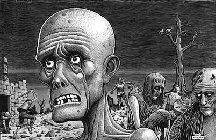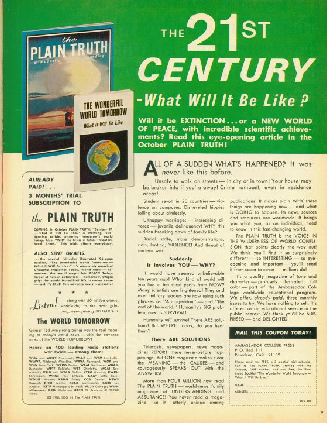


Researching the Worldwide Church of God under
Founder Herbert Armstrong:
Print and Online Resources
The Worldwide Church of God was a relatively small denomination during the lifetime of its founder, Herbert W. Armstrong. Estimates indicate there were likely never as many as 100,000 adult baptized members at any one time, even in the group’s heyday.
It did, however, have a period of two decades, from the mid-

As a snapshot in time, one book about the WCG from the 1970s records that in 1969:
The Plain Truth passed the 2,000,000 mark in monthly circulation. [It had been c.50,000 in 1951.]
The daily half-
The program was also heard on 182 local US radio stations
The program as also heard on 42 Canadian radio stations, including four in the French language and two in Italian
The program was also heard on 4 European radio stations, including MANX radio in English and three Spanish language stations; on stations in Okinawa and Guam, on 21 stations in the Caribbean and Latin America including 17 in English and 4 in French
The weekly half-
In other words, in America you could twirl your radio dial at night any night of
the week, and during any half-
Upon Armstrong's death, country music artist Merle Haggard related that "after Johnny [Cash] died, I lost a real close friend in Garner Ted Armstrong. He was like a professor to me. What education I have, I owe to him. There was a period where I didn't even want to watch the news to see who else was gone."
His rapid-
Yes, the WCG (originally named the “Radio Church of God” until a namechange in January
1968) did play a significant part in the religious scene for a while in the mid-
The purpose of this webpage is to provide a listing of web material and published
books
that may be useful to anyone wanting to dig more deeply into
the history of
the organization
up through the death of Herbert Armstrong in January 1986.
Online Materials
From the Website:
In 1975 a group of Ambassador College alumni decided it was time that the truth about
Herbert W. Armstrong's Ambassador College, Plain Truth magazine, Ambassador Foundation,
and Worldwide Church of God be made known, especially to those financially supporting
those institutions. This small group of alumni formed a publishing association called
Ambassador Review which in mid-
The entire Ambassador Report collection represents the most thoroughly researched,
frank, and shocking series of exposes ever done on the inner workings of what has
been called the Armstrong Empire. The Report has also reported extensively on the
dozens of colorful spin-
Particularly poignant articles from the two first issues of Ambassador Report (called Ambassador Review in 1976)
A Treasury of Famous (failed) Prophecies
Herbert W Armstrong—Man on the Move
Herbert W Armstrong: A Legend in His Own Mind
Garner Ted Armstrong: Son of the Legend
The Booklets Nobody Wants to Talk About
Herbert Armstrong “Disproves” the Bible
Modern Moloch—Human Sacrifice in the Armstrong Church
Actual photocopies of newspaper articles about the Armstrong Empire from the 1970s and 1980s.
Click on the photos when you get to the page to enlarge them to full size
Bob Gerringer's 1975 open letter to Worldwide Church of God (WCG) evangelist Charles Hunting, explaining the theological and ethical reasons why he and his wife Connie left the WCG (28 pages).
Did Christ Reorganize the Church? By Herbert W Armstrong
Published in 1939, HWA attacks the very organizational methods he later adopted (10 pages).
Must God’s Ministers Be Ordained by the Hand of Man?
A January 1960 Good News magazine article, in which Herbert Armstrong affirms that ALL ministers must be ordained by another minister in the line of ordained men going back to the Apostles. He describes his own ordination in 1931, by other ordained elders.
Herbert Armstrong’s Baptism by a Baptist Minister
See page 4 of this Good News magazine, in the “Personal from the Editor” article, for HWA’s own description of his baptism.
John Kiesz’s overview of the ministry of Herbert Armstrong
Note on the website linked above: John Kiesz, an elder in the Church of God (Seventh
Day), Denver, CO, was editor of the COG (7th Day) magazine, the Bible Advocate in
the early 1930's. He was very close friends with Herbert Armstrong from 1935-
[The document on the page is an open letter from John Kiesz sent out to those who sent inquiries to John Kiesz about Herbert Armstrong. Here is the intro to the letter from Keisz:]
To Whom It May Concern:
Since the early 1960s we have often been asked, mostly through letters, what we know about Herbert W. Armstrong, whether he has ever been a member of the Church of God (7th Day), and if so, why is he not with this church today, was he disfellowshipped or did he leave of his own accord, and if so why; can one rely on his autobiography, and what do you think of his present work, his attitudes, and teachings?
Robert Coulter, former CG7 President, overview of the ministry of HWA and COG history in general
A summary of a 2008 presentation by Robert Coulter in the Journal, News of the Churches of God: “A longtime member of the General Conference of the Church of God (Seventh Day), the parent organization of Herbert W. Armstrong's Radio Church of God and Worldwide Church of God, traced the Churches of God's history from the Great Disappointment of 1843.”
Daughter of Babylon, the True History of the Worldwide Church of God by Bruce Renehan
Although I do not agree with all of the conclusions about specific doctrines arrived at by this author, his extensive documentation and commentary about many topics related to the history of the WCG is extremely compelling.
American Waldensian Society Letter
A letter from modern Waldensians denying the validity of the “history” used by Sabbatarian groups such as the WCG to push Waldensian history before the 1100s.
Letter from the Seventh Day Baptist Historical Society denying the claims of history of the Sabbath as promoted in True History of the True Church.
Online library of almost all publications of the Radio Church of God/Worldwide Church of God
Site includes:
PDF files of virtually every Plain Truth, Good News, and Tomorrow’s World magazine published during the lifetime of HWA
PDF files of most of the rest of the literature published by the Radio or Worldwide Church of God, including books, booklets, Worldwide News member newspaper, hymnals, and more
A complete downloadable “searchable” library of much of this material, and including
ALL the member and co-
Church of God Timeline 1830-
Significant events in the history of the Churches of God leading up to the formation of the Radio Church of God, through the Worldwide Church of God, and through its splits up to 2004
Another COG Timeline, this one “from 1800 to the present, with emphasis on the period
1860-
The previous timeline above emphasize the dates of general events, particularly those of interest to exWCG members. It was compiled in as neutral a way possible. This one is much more detailed, and was compiled by a person deeply dedicated to the memory of Herbert Armstrong–touches of that show through. But the documentation is likely quite accurate. It includes detailed time entries for the Church of God Seventh Day right up to the present, and appendices with information from several other authors, including a detailed listing of performances in the Ambassador Auditorium.
Where are they now? A “List of Pioneers or Senior Veterans of the WCG”
This list includes some extensive details on the doings up to the present, or up
to their own death, of various men … and a few women … significant in the history
of the WCG. It was compiled by a person deeply dedicated to the memory of Herbert
Armstrong, so some of the commentary reflects that. But the documentation is likely
quite accurate. Included is an interesting brief biography and list of accomplishments
of Art Gilmore, the man whose voice started introducing the World Tomorrow radio
program in 1947, and stayed with it, and the later TV version, throughout its history.
He was not affiliated with the WCG, but was instead an exceptionally well-
It also includes a nice overview of the life and work of Basil Wolverton, the illustrator for the WCG’s Bible Story books and the artist whose gruesome drawings made the WCG’s 1975 in Prophecy and The Book of Revelation Unveiled at Last booklets so terrifyingly memorable. Wolverton was a member of WCG, and, in fact, an ordained elder. But he had also been a famous cartoonist in his own right since the 1930s, working primarily in the fields of science fiction and action comic books, along with Mad Magazine.
Audio recording by Ken Westby from 1974 outlining the issues in the history of the WCG that led up to the formation of the first major “split” off the WCG, the Associated Churches of God.
This link is to a transcript of the tape. Information on the recording itself is available at the link.
Former members of the WCG under Herbert Armstrong may find it interesting and instructive to compare what they remember of “life in the WCG” to a common list of sociological, psychological, and behavioral patterns and characteristics of groups considered harmful cults. This has nothing to do with the religious definition of the word cult, which is usually based on theological matters. A group could be totally “orthodox” in the eyes of the “Christian mainstream,”–and still be a harmful cult by the standards in lists such as this one. Groups which exhibit these characteristics are physically, emotionally, and psychologically, harmful to members. (See an explanation of the use of the term harmful cult or harmful religious group as it is used on this Field Guide site for more clarification on this topic.)
Books about the history of the WCG and HWA
The Armstrong Empire: A Look at the Worldwide Church of God
Hopkins, Joseph Martin
William B Eerdmans Publishing Co
1974
At the time of writing this book, Hopkins was a Professor of Religion at Westminster College, contributing editor to The Presbyterian Outlook, and an author of articles published in a number of magazines and journals including Christianity Today.
This book is exceptionally objective—and meticulously and copiously documented—in its description of the history, practices and doctrinal beliefs of the WCG, compared to many others written by Protestant authors critical of WCG doctrine.
Although the author does spend some time dissecting the doctrines and presenting counter arguments from his point of view of scripture, he does not engage in erecting "straw men" about Herbert Armstrong's teachings, as have a number of other more sensationalistic books.
He documents most of the concepts that he addresses with quotes directly from WCG materials, and presents a summary of doctrinal WCG beliefs in an appendix that was, he notes, prepared by an Ambassador College graduate. He also presents an extensive collection of interviews with and comments by present and former members of the WCG, as well quotations from a wide variety of other authors who had done research on the organization. (304 pages)
Armstrongism: Religion or Rip-
McNair, Marion
Pacific Charters, Orlando FL
1977
Marion McNair was one of the earliest students at Herbert W. Armstrong's Ambassador College, graduating in 1954, and one of the first men to be ordained to the rank of "evangelist" in Armstrong's Radio Church of God (later Worldwide Church of God).
This book, written shortly after he resigned in disgust from the organization, contains some of the most extensive documentation and details available in print on the development of Armstrong's ministry. It starts in the earliest days in the 1930s while Armstrong was still affiliated with the Church of God, Seventh Day, and continues right up to the time of the upheavals in his organization after the failure of his 1972/1975 prophetic scenarios. (339 pages)
The Broadway to Armageddon
Hinson, William B
William Hinson, Hohenwald TN
1977
Overview of the Worldwide Church of God by a former WCG elder. Hinson had been involved with the Radio/Worldwide Church of God since 1962. He was ordained as a deacon in 1965 and as an elder/minister in 1969. He left in disgust in 1976 and wrote and compiled this book.
A number of the chapters are collections of memoirs of other former members, resignation letters from ministers and members, personal correspondence between those in leadership positions in the organization and so on.
One of the most valuable contributions of this book is its emphasis on personal stories of unnecessary suffering among the membership brought on by the unbiblical, ungodly and unethical teachings and policies of the Armstrong system.
Most of the other books critical of the movement focus rather on theological arguments about Herbert W Armstrong's doctrines, or exposes of the unethical or immoral financial, sexual, administrative and other shenanigans of the leadership. (234 pages)
Herbert Armstrong’s Tangled Web
Robinson, Dave
John Hadden Publishers, Tulsa OK
1980
The description of the late Dave Robinson from the back cover of the Tangled Web book:
He began to listen to Herbert Armstrong on the radio from a Mexican station in 1949 and became a heavy financial contributor soon after. He met HWA the next year and became a member and supporter of what was then the Radio Church of God. He supported Herbert Armstrong for a full three decades.
In 1969 he went to work full-
Among the responsibilities carried by Dave were those of administrator, counselor, lecturer, security chief, and minister. He was a confidant of many of those men who have either been removed from the church altogether or have been relegated to dishonor within that organization.
He writes from firsthand knowledge tempered with deep disappointment and has come to agree completely with Solomon who advised against putting trust in men.
Robinson's book contains the most intimate view of the inner workings of the organization, and the most candid of descriptions of many of the principle players in the saga, of any of the books available on Armstrongism.
The Truth Shall Make You Free
Tuit, John
The Truth Foundation, Freehold Township NJ
1981
Author Tuit provides an overview of the turmoil in the Worldwide Church of God in the late 70s and early 80s. He began reading the church's Plain Truth magazine in 1957, and began contributing to what was then called the Radio Church of God in the early 1960s. He became a baptized member of the Worldwide Church of God in 1975. In 1978 he became so totally disillusioned with the leadership of the WCG after Garner Ted Armstrong's ouster that he cooperated with a handful of other members to organize the suit against the WCG that resulted in the imposition by the state of California of a Receivership in January 1979.
Although he does touch upon a variety of details about the history, doctrine and practices of the WCG, his book adds little to the collection of this information available from many other sources. However, the book is the most effective chronicle available of the events leading up to and during the Receivership because Tuit had first hand knowledge of much that went on behind the scenes.
Return to Top of Page and the Navigation Bar